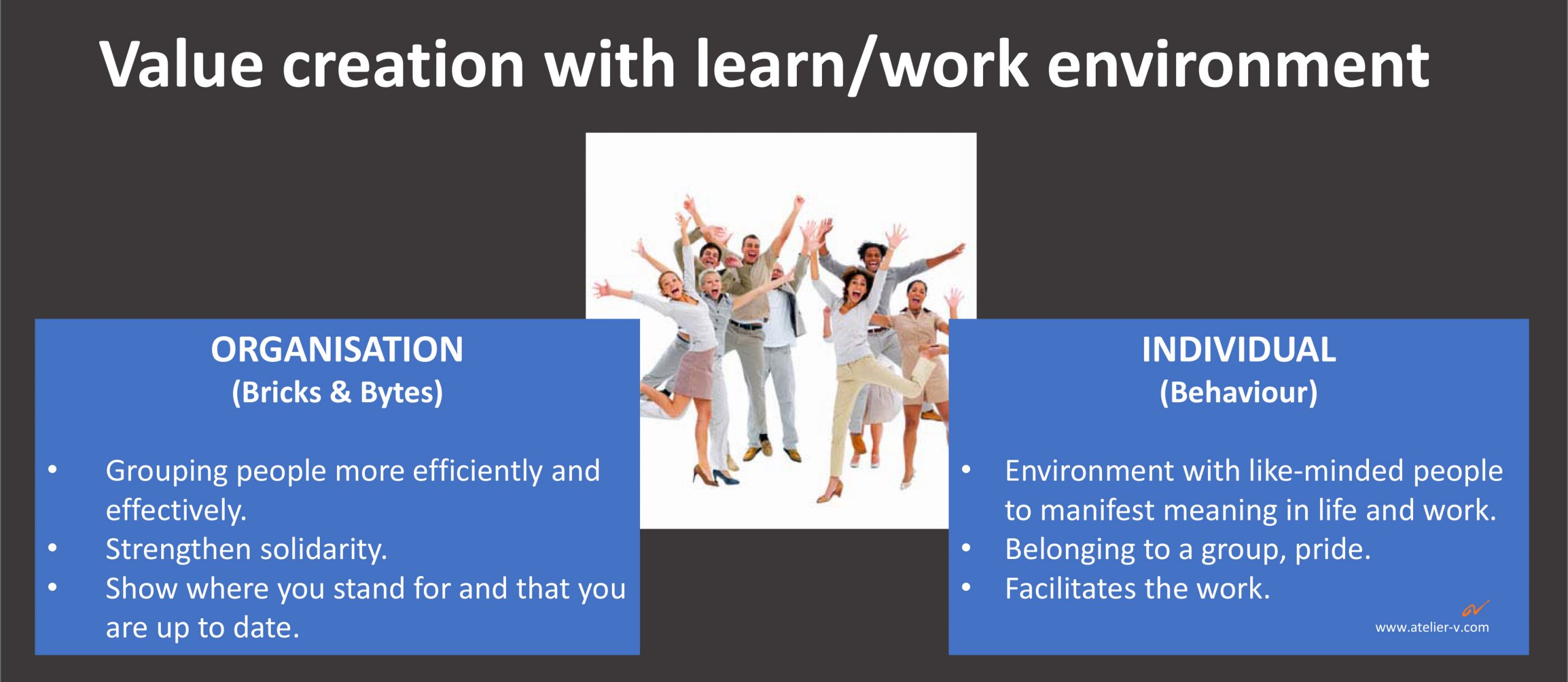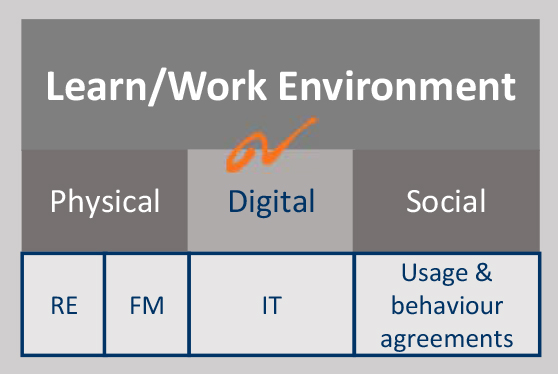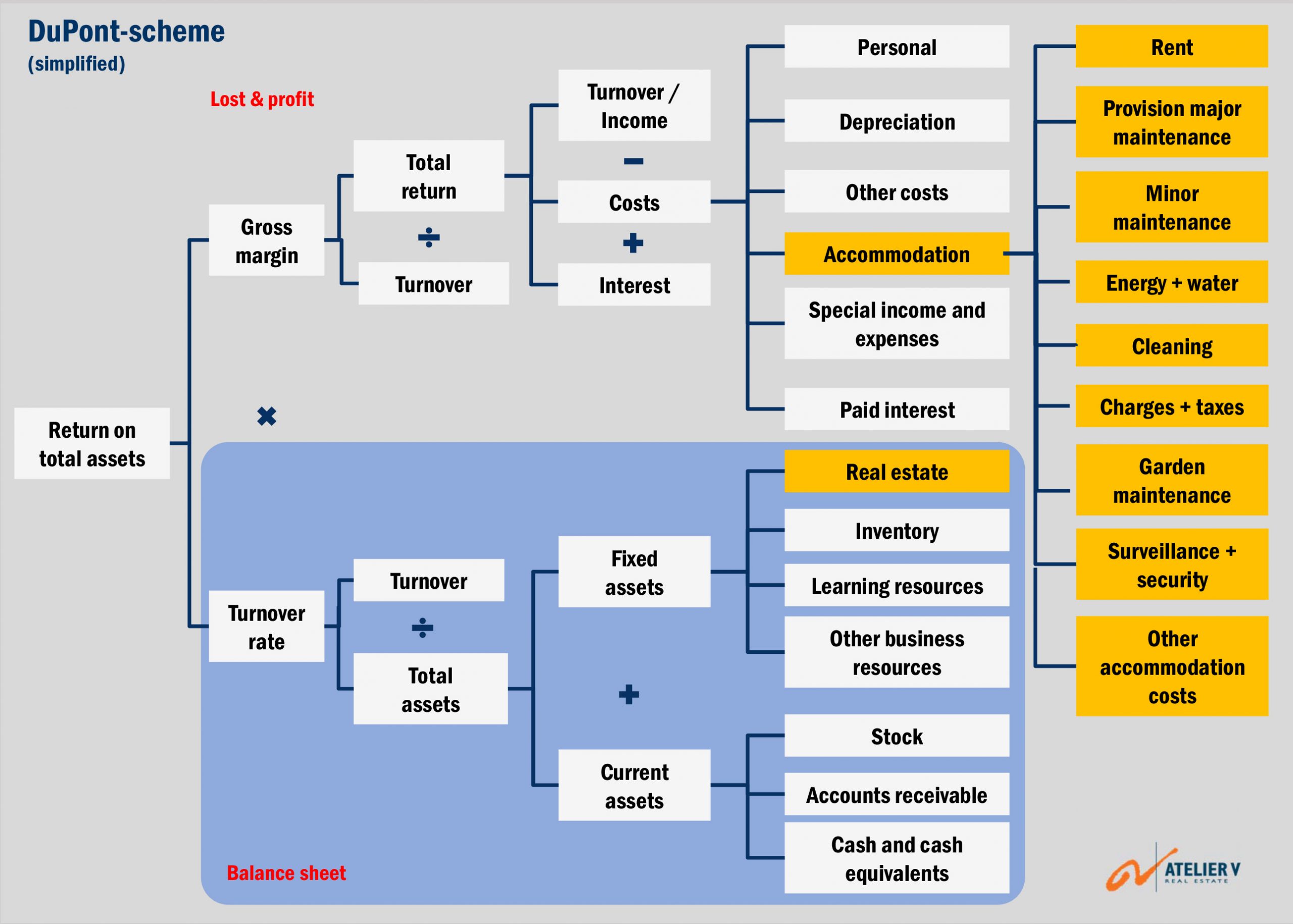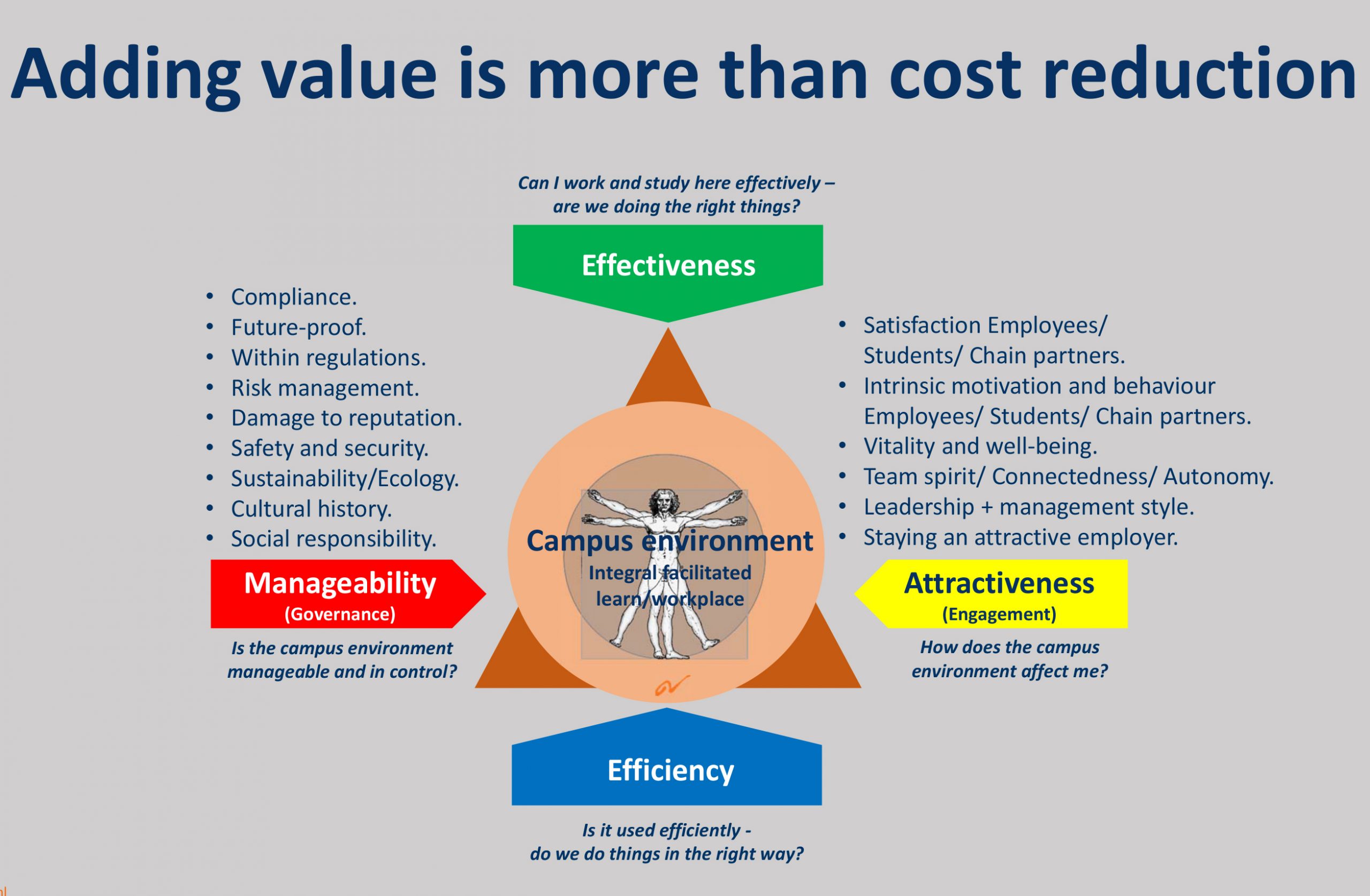Creating added value through the use of accommodation requires thinking differently about the learning/work environment. From cost- and risk-driven management and maintenance to value-driven accommodation management to achieve the organisation’s objectives in conjunction with other policy areas from ‘What does it cost in the short term?’ to thinking more about ‘What is the added value in the mid and long term?’.

Return and/or added value
This approach requires professional knowledge and integrated thinking about the balance between performance, risks and costs, life cycle thinking, evaluation, and improvement. It also requires integrated cooperation based on appropriate roles and business operations. To focus more on the return on accommodation, it should be clear what precisely this return is. Returns are often (only) linked to the revenues from shared use (by third parties).
At the same time, there is a realisation that the accommodation should, in the first place, create added value for the primary process of the organisation that is using it. Added value can be tangible or intangible, financial or non-financial and includes considering risks and liabilities. Value can be positive or negative at different stages of the life cycle of the learning/work environment. Realising value usually involves balancing costs, risks, opportunities, and performance benefits. For this, an integral business value case is required.
The business value case gains insight into the effects that the learning/work environment has on financial management. It makes potential positive and negative leverage effects visible and distinguishes projects between “need-to-have” and “nice-to-have”. Think first, then act.
By connecting strategic objectives via tactical planning with operational execution, hidden failure costs are reduced. It avoids planning the front too little because of penny-wise pound-foolish decisions to not spend any money on thorough preparation. Money that, most of the time, still had to be spent because things went wrong due to the hit-and-run mentality. It connects the processes of renovation, construction, and accommodation management. It makes thinking in lifecycles and layers of change more applicable.
For integrated considerations and justification, one has to move away from traditional investment thinking and towards Total Cost of Ownership (TCO) thinking.
Strategic Alignment
A prerequisite for adding value is a clear vision/strategic policy regarding accommodation in the long term. Furthermore, this policy should be linked to the educational institution’s social/ pedagogical vision as well. Alignment of the learning/work environment translates the organisation’s strategic objectives into technical and financial decisions, plans, and activities. Although challenging in practice, the connection between the strategic and operational levels is essential for success.
A Strategic Alignment Matrix helps to determine a vision of the required added value of the learning/work environment to create a business value case. It is a dynamic document with a series of unambiguous, recognisable and practically applicable criteria about Engagement, Effectiveness, Efficiency and Evidence of the physical, digital and social learning/work environment. It gives policy directions to integrate these four subjects into a more holistic lifetime approach and facilitates the conversation about the desired level of added value. During the in-use phase, it forms the reference frame for an accommodation roadmap and an annual building performance review for continuous improvement.
Integrating the physical, digital and social learning/work environment criteria helps determine its investment program, which is necessary for the desired added value. Doing so helps to formulate ambitions at an early stage and gain insight into the required investment/ funding for the accommodation roadmap/Real Estate GPS.
Understanding the “physics of values” can help us create sustainable value that will allow the whole system to flourish. An “integral” perspective on quantitative and qualitative approaches is required for this. Efficiency is the ratio between output and input. Accommodation performance for an organisation is the output. The input is the cost of the accommodation. The performance of the accommodation is made transparent based on the added value of accommodation and associated goals or standards. The rate at which the goal is achieved constitutes performance.
In other words, to be able to say something about the return, added value or performance of the accommodation, the intended purpose must be clear. Which user’s organisational goals need the accommodation to contribute to? What is the desired added value of the accommodation for the organisational objectives? And what is the actual performance of the accommodation? The comparison of the desired and present performance gives a performance analysis with which the accommodation’s yield (in the broadest sense of the word) can be determined.
Benefits are defined as the difference between value and price on the demand side, and profit is defined as the difference between price and cost on the provider side. Price is the matching mechanism between supply and demand.
It is about ‘fit for purpose,’ and this differs per building function and user. What is fit for one user’s (his) purpose is not necessarily fit for another user in the same building.
Integrated understanding
Value engineering is about the relationship between intrinsic use value (for an organisation and its employees), the total cost of ownership, and the market price. It requires managing the ecosystem of bricks, bytes, and behaviour to create lasting value. Focus on the stakeholders instead of just the shareholders so everyone flourishes. It is about the well-being of everyone within the company and outside it.
A new level of integrated understanding is emerging. Accommodation is more than just a necessity; it also adds value (an increase in benefits and reduction of costs). All interrelated variables are to be made explicit and measurable. Taking them into account earlier will save money later during operation.
At first sight, buildings may look the same. They can even have the same price. Yet, some differences make one building less efficient and more costly to refurbish for the intended work processes than the other. The purchase price is the same, but the value for the user differs.
Value creation with the learning/work environment must be balanced with the costs, risks, and time involved in initiating, implementing, and operating accommodation. Value creation is doing the right things (effectiveness) in the right way (efficiency). Be aware that emotion steers behaviour. Engagement aspects should, therefore, be taken into the equation.
The first level of value creation often used is less space with better quality and better management. The next level is creating a hybrid place and space, making the home and public third places between home and work a structural part of the accommodation portfolio. This approach offers the potential for change and possible innovation breakthroughs without the main social learning/work environment that avoids or sometimes even inhibits change.
“Value creation through the learning/work environment arises from the mix of characteristics (performance) that are relevant to the primary process and the stakeholders.” (René Stevens)
Focus on people and their Behaviour instead of mainly on the processes, procedures, and structures of the organisation, the Bricks & Bytes. Only when employees share the organisation’s dream does synergy arise, and they become intrinsically motivated to increase productivity and add (more) value. Cultures are shaped by their environments.
Smart Management is when a learning/work environment focuses on increasing the effectiveness and benefits of the activities in that environment and less on the cost reduction of the accommodation.
“Value engineering is about the needs and requirements of an organisation as a whole and the individual user requirements of the employees/students in particular.”
(René Stevens)
A main focus on cutting costs usually means cutting corners, reducing quality, and affecting customer satisfaction and brand loyalty.
Distinction between price and worth
Does the price of real estate equal the subjective worth attributed to it, or is the worth of the object the same as the (market) value? In ordinary language, is the worth of real estate similar to whatever you can get for it?
- Valuating – Process of determining the market price.
- Market price (value) – An estimate of the price the property can fetch on the market at this point in time.
- Price – Actual trade price in the market.
- Valuation -The ‘best estimate of the actual market price by an expert.
- Appraisal – Process of estimating the intrinsic value for an individual or a group of individuals.
- Intrinsic value (worth) – Personal (subjective) estimate of the intrinsic value by the party/parties concerned.
- Added value (value for money) – The independent simulation of the weighing process of the real estate players in determining their intrinsic value in a given context.
The price is the only thing that really exists, for it is the amount mentioned in the tender brochure or the lease or sale contract. The (objective) value of the real estate does not exist, for it is an individual and, therefore, subjective estimate in a given context.

Value creation
If the organisational goals are defined objectively and measurably and translated into the required learning/work environment performance, this limits risks and increases opportunities.
The learning/work environment is a catalyst for people’s performance and, therefore, has a strategic impact and drives revenues.
Most of the performance constraints are in the business’s processes, not the people. It’s unfair to hold any individual person accountable for a performance result that is constrained by the business system and/or the learning/work environment.
At the heart of value creation is exploring the learning/work environment as an interconnected and interdependent eco-system of Bricks, Bytes, and Behaviour. That requires optimising the feedback/feedforward loops between the inseparable “silos” of Real Estate (RE), Facility Management (FM), Information Technology (IT) and Human Resources (HR).
The model of three domains, Physical, Digital and Social, helps to properly discuss how to facilitate an integrated learning/work environment. The domains are partly different, and partly, they come together and overlap. Sometimes, they create synergy, but quite often, tensions exist. A good learning/work environment must care for what it does in these three domains. Focus on the balance between the physical, the digital and the social environment.
This model helps to show problems in an unbalanced learning/work environment that narrows its focus to only one or two domains instead of all three. Measuring the added value of the learning/work environment should address all three domains in an interrelated way.
Addressing the larger framework in which the “silos” exist and interact with each other and the entirety of the whole, re-establish integrated wholeness. This may feel complex initially, but remember that the whole is more than the sum of its “relatively independent” parts. Only a total ecosystem approach will create the real added value.

A holistic vision is important here. A conductor ensures that the various parts of the learning/work environment (RE, FM, IT, HR) are coordinated so that they optimally facilitate the organisation’s most important capital: the employees. To this end, the conductor coordinates the periodic measurement and analysis of the learning/work environment’s performance. Remember that what is important to measure is not necessarily easy to measure.
Decisions about the learning/work environment have a great financial impact because they impact not just occupancy costs but the viability of the whole organisation.
Sustainability is an important theme in value engineering and requires an integrated and holistic approach. A sustainable learning/work environment connects people, profit, and the planet. Usually, one builds on costs rather than on value.
“Don’t think of costs; think of value. You don’t need permission to add value.” (René Stevens)
Value creation with the learning/work environment consists of the following:
- Direct income is achieved through sales (the positive difference between book value and sales price) and rental income (shared use and rental to third parties).
- Direct cost reduction is achieved by reducing the number of square meters of floor space and reducing occupancy costs per square meter.
- Indirect benefits because the learning/work environment positively influences the return from the primary process. Plus, it contributes to achieving the sustainability objectives as part of the social return.
- Indirect reduction in total operating costs (excluding occupancy costs) through a more efficient and effective learning/work environment for the education and research process.
All aspects come together in a business value case calculation (evidence-based investment roadmap), in which the benefits and costs are made explicit to determine whether the benefits justify the costs.
The impact of welness
Healthy features are good for people and, therefore, for the organisation. Health and well-being metrics in the learning/work environment significantly impact the most significant costs, namely personnel, and should, therefore, be an integral part of any value engineering or optimising of operational expenditures in general.
The financial effects of chronic illness resulting from learning/work environment-related stress can be divided into direct costs (insurance/medical, absenteeism, compensation, presenteeism) and indirect costs (engagement/morale, overtime costs, overstaffing due to low productivity, customer delays, accidents).
Before we can improve the learning/work environment, we must first change ourselves: become aware, take responsibility, and take action! (René Stevens)
A learning/work environment is more than a collection of ‘workplaces’. It is all about ‘places that work’ for you, the user, inspiring environments that generate energy, where people meet, collaborate and exchange knowledge and information. A place where they experience a sense of belonging. In short, Places that Matter. Success does, however, not only depend on a smart design but also on the proper use of the environment, the right attitude, the behaviour and culture of the employees and the employer’s management style.
Accommodation budget

The learning/work environment is one of the critical secondary business processes. It requires integration and coherence with other business processes, such as Human Resources, Finance, Sales & Marketing, and the associated systems, so that in addition to supporting the primary process, internal information provision and external accountability are in order.
Just as an annual formation and financial budget is made to be in control and to steer, an accommodation budget can also be drawn up. The accommodation budget consists of the elements of the Six Pack monitoring system; it is a total cost of ownership approach.
By definition and measurement agreements, the sub-budgets of departments and business units can be “added up” to form a consolidated accommodation section in the annual report.
There is always pressure on the available financial budget, for which evidence-based value engineering will support the decision-making about budget allocation between education, research, and the learning/work environment in which it all takes place.
Dare to think big as an organisation, but start small and expand incrementally. Innovation is impossible without experimentation. Experiment and gradually find out which form and speed of implementation suit the organisation best. Have faith in the process. Like anything new, it takes a bit of trial and error before you get it right, but the payoff is worth it.
ATELIER V supports the preparation of Scenario analyses, Integrated Business, and Value cases. Would you like more information or an informal conversation? Email us, and we will be happy to help.

